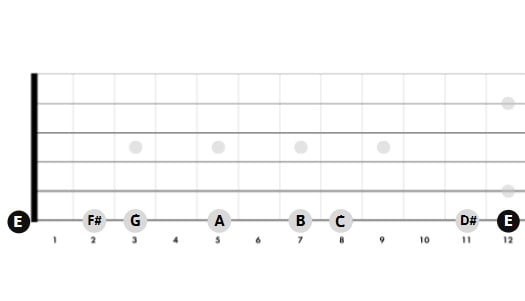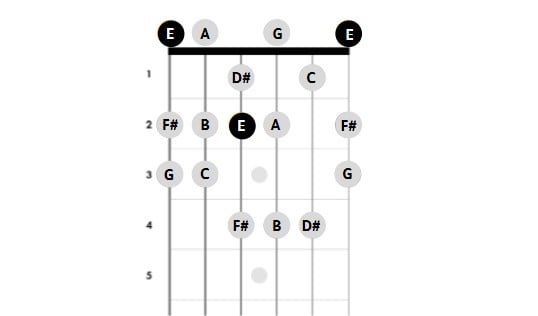With its distinct sound, the E harmonic minor scale is a favorite among players who specialize in styles ranging from neo-classical and jazz to metal and surf guitar. Sometimes referred to as the Mohammedan scale due to its Middle Eastern sound, the harmonic minor scale is an excellent scale to learn if you are interested in adding new sounds to your improvisation toolkit.
In case you’re already familiar with playing natural minor scales, you might notice that the harmonic minor scale shares all but one note with the natural minor scale. The raised seventh note of the harmonic minor scale gives it a unique flavor that makes it an interesting scale to learn. In this lesson, we will focus on the E harmonic minor scale, one of the most commonly used harmonic scales, and learn how to play it in two positions. We’ll also practice the chords that accompany this scale and learn a movable version of it to help you master this scale on the guitar.
Contents
Notes on the E harmonic scale
The E harmonic minor scale consists of seven notes:
- E
- F#
- G
- A
- B
- C
- D#
In any key, the harmonic minor scale uses the following intervals: Whole step, half step, whole step, whole step, half step, whole and a half step, half step. The whole-and-a-half step between the C and the D# in the E harmonic minor scale creates an augmented second between the sixth and seventh notes of this scale.
E harmonic minor scale positions
You can play the E harmonic minor scale in many positions on your guitar’s neck. For this lesson, we will focus on two positions and learn the correct finger placement to play these scales properly. Using diagrams to represent the neck of your guitar, each dot shows you which note to play on a specific fret and string. The yellow dots indicate the root note of the scale — in this case, the root note is E.
The E string
One way to play the E harmonic minor scale is on your guitar’s low or high E string. To play the scale in this way, you will need to shift your hand several times as you move up the neck. Start by playing the E string open, then use your index finger to play the 2nd fret and your middle finger to play the 3rd fret. Shift your hand so that your index finger can play the 5th fret and your ring finger can play the 7th fret. Shift again so that your index finger can play the 8th fret and your pinkie can play the 11th fret. Finally, slide your pinkie up one fret to hit the note on the 12th fret.

Open position
You can also play the E harmonic minor scale in the open position. To play the scale in this position, use your index finger to play notes on the 1st fret, your middle finger to play notes on the 2nd fret, your ring finger to play notes on the 3rd fret, and your pinkie to play notes on the 4th fret. Then, move your hand up to the 5th fret and use your index finger to play notes on the 5th fret, your middle finger to play notes on the 6th fret, your ring finger to play notes on the 7th fret, and your pinkie to play notes on the 8th fret. Finally, move up to the 12th fret and use your index finger to play notes on the 12th fret, your middle finger to play notes on the 13th fret, your ring finger to play notes on the 14th fret, and your pinkie to play notes on the 15th fret.

E harmonic minor scale tabs
After learning how to play the E harmonic minor scale in two positions using guitar scale diagrams, you can now follow the tabs to play this scale.
High E string
The first tab shows how to play the E harmonic minor scale on the high E string. Remember to shift your hand position up when you reach the 5th, 8th, and 12th frets.

Open tab position
The second tab shows how to play the E harmonic minor scale in open position on the low E string. Keep your hand in the same position throughout and use your index finger on the 1st fret, your middle finger on the 2nd fret, and so on.

E harmonic minor scale chords
To complement the E harmonic minor scale, there are many chords that you can use to create an interesting chord progression. By pairing chords with this unique scale, you can explore various possibilities for creating music. Since there are seven notes in the E harmonic minor scale, we will look at seven chords that correspond to each step in the scale: E minor, F# diminished, G augmented, A minor, C major, B major, D# diminished
The moveable harmonic minor scale
In addition to the E harmonic minor scale, there is a moveable harmonic minor scale pattern that you can learn. Since scales and chords are based on intervals, many guitar scales and chords are based on moveable patterns. By learning this moveable scale pattern, you can play this scale in any key, anywhere on your fretboard.
To play the F# harmonic minor scale, shift up a few frets from the E harmonic minor scale we just learned. This pattern will feel slightly different because you are no longer using open strings. Start with your index finger on the 2nd fret, F#, of your low E string, then use your fingers to play notes on the E, A, and D strings. Once you reach the G string, shift your hand position back one fret so you can play notes on the G, B, and high E strings.
You can also play this same scale pattern but starting with your index finger on the 3rd fret, G. This will allow you to play the G harmonic minor scale. Don’t forget to shift your hand back a fret when you reach the G string so you can play notes on the B and high E strings. You can start this scale at any note on the low E string of your guitar by using the same pattern.
You can also play the G# harmonic minor scale by starting this scale with your index finger on the 4th fret. The starting note for this scale is its root note, so you now have the power to start this scale at any note on the low E string of your guitar.
E harmonic minor scale excercises
To improve your skills in playing the harmonic minor scale, the best way is to practice playing it repeatedly. Begin by playing the E harmonic minor scale in ascending and descending order on the low E string of your guitar. Then, play the same scale on the high E string and notice how the notes sound in a higher register. To add some variety to your practice, you can try tremolo picking for a surf effect.
You can also practice playing the moveable scale in different positions on the neck of your guitar. Start on the 2nd fret of your low E string, F#, and play through the scale in ascending and descending order. Then, move your hand position up one fret to start on the 3rd fret, G, and continue playing the scale until you reach the 14th fret, which is F# again.
By practicing the harmonic minor scale in this way, you can improve your dexterity in both your fretting and picking hands while also training your ear. If you want to learn more about how the harmonic minor scale is used in popular music, you can visit Guitar tunio for more information.
